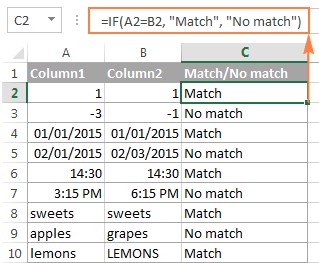Comparing data in Excel is a common task, and often involves comparing two columns. This guide explores various techniques in Excel to compare two columns row-by-row, identify matches and differences, and highlight results for better visualization.
Comparing Two Columns Row-by-Row for Matches and Differences
The simplest way to compare two columns row-by-row is using the IF function.
Finding Exact Matches
To find matching cells in the same row (e.g., A2 and B2), use this formula:
=IF(A2=B2,"Match","")This formula compares the values in A2 and B2. If they are equal, it returns “Match”; otherwise, it returns an empty string.
Finding Differences
To identify differences, simply change the equals sign to the not-equal-to sign:
=IF(A2<>B2,"No match","")This returns “No match” if the values differ and an empty string if they are the same.
Showing Both Matches and Differences
You can display both matches and differences using a single formula:
=IF(A2=B2,"Match","No match")These formulas work with numbers, dates, times, and text strings. Note that by default, text comparisons are not case-sensitive.
Case-Sensitive Comparison
For case-sensitive matching, utilize the EXACT function:
=IF(EXACT(A2,B2),"Match","")Comparing Multiple Columns in the Same Row
You can also compare multiple columns simultaneously based on different criteria.
Finding Matches Across All Columns
To identify rows where all cells have identical values, use the AND function within the IF function:
=IF(AND(A2=B2,A2=C2),"Full match","")For a larger number of columns, the COUNTIF function offers a more concise solution:
=IF(COUNTIF($A2:$E2,$A2)=5,"Full match","")Replace “5” with the actual number of columns being compared. This formula checks if the count of the value in A2 across the range A2:E2 is equal to 5 (the number of columns).
Finding Matches in Any Two Cells
To find rows where at least two cells match, use the OR function:
=IF(OR(A2=B2,B2=C2,A2=C2),"Match","")For many columns, combining multiple COUNTIF functions can be more efficient:
=IF(COUNTIF(B2:D2,A2)+COUNTIF(C2:D2,B2)+(C2=D2)=0,"Unique","Match")This formula checks for matches between each pair of columns and returns “Match” if any match is found.
Comparing Two Columns for Matches and Highlighting Differences
Beyond simple comparisons, you can highlight differences for easier identification using conditional formatting.
Highlighting Matches in Two Separate Lists
To highlight matches between two separate lists (e.g., column A and column C), use conditional formatting with the following formula:
For List 1 (Column A):
=COUNTIF($C$2:$C$5,$A2)>0For List 2 (Column C):
=COUNTIF($A$2:$A$6,$C2)>0These formulas highlight cells in one list if a match is found in the other.
Formula-Free Comparison: Third-Party Tools
For users seeking a more visual and user-friendly approach, third-party add-ins like “Compare Two Tables” within the Ablebits Ultimate Suite offer formula-free comparison options. These tools can compare multiple columns, highlight matches and differences with various colors, and generate reports summarizing the results.
Conclusion
Excel provides a versatile toolkit for comparing two columns using formulas and conditional formatting. Whether you need to find exact matches, identify differences, or highlight results, the techniques outlined in this guide empower you to effectively analyze and compare your data. Third-party tools offer additional features for a more streamlined and visual comparison experience.

